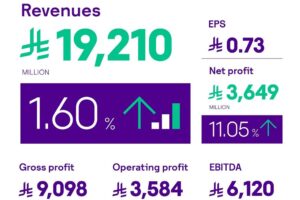By: Dr. Abdulhadi Mahmoud AbouAlmal
The mobile industry is the engine for national digital transformation and the foundation for the digital economy that will shape our economy and society in unprecedented ways in the next decade. PWC estimates that 5G technology will add $1.3tn to global GDP by 2030. This digital universe has seen the emergence of new services such as HD video, XR, and the metaverse. These evolutions raise the requirements for higher data rates such as 1Gbps anytime, anywhere and 10Gbps in hotspots to support a ubiquitous digital user experience.
To that end, a sufficient mid-band spectrum will be mandatory for future mobile service growth. GSMA Research estimates that mid-band 5G (1GHz – 7GHz) could deliver $610B GDP growth in 2030 (63.5% of the total 5G benefit). The GSMA also says an average of 2GHz mid-band per country is necessary as spectrum reserve for mobile services in the next decade. To secure optimal 5G performance in the long-term, more capacity in this range is needed, and 6 GHz is a prime candidate.
To build on this momentum, the mobile industry supported the adoption of 6GHz for 5G and beyond. The World Radiocommunication Conference 2019 (WRC-19) agreed to establish a new agenda item to study upper 6GHz for IMT (International Mobile Telecommunication) at WRC-23. Additionally, the GSMA has advocated 6GHz as the primary band for the future of 5G evolution and officially set up a 6GHz Supporting Group. Furthermore, several countries and MNOs have launched 6GHz IMT field tests between 2021 and 2022 such as “etisalat by e& in UAE.
Such ongoing global collaboration is important to cultivate the 6GHz IMT ecosystem to get it commercially ready for IMT evolutions beyond 5G by 2025 timeframe. Some countries have already announced consideration of 1.2GHz bandwidth within the 6GHz band for 5G and beyond. Other countries considered the split of the band, with the upper 700MHz portion potentially being planned for 5G and its evolution, while the lower 500MHz tranche is made available for exempting license. (e.g. Wi-Fi, 5G NR-U (New Radio Unlicensed), among others.
Be practically irreversible, leading to an imbalance in such mid-bands assignment along with a great opportunity loss for 5G technologies and economies. In addition, Wi-Fi user experience could be limited by broadband fixed access network capacity and penetration, unlicensed technology limitations and low-end access points rather than the shortage of spectrum.
Therefore, it is important to weigh the decisions carefully when allocating frequencies to licensed or unlicensed operations in the 6GHz band, noting that we have already seen how mid band can drive 5G network evolution. Furthermore, using advanced Massive MIMO technologies, 6GHz can achieve similar coverage as C-band with even higher capacity, making 6GHz an ideal band for balancing the capacity and coverage necessary to meet future wide area deployment requirements in a cost effective manner.
The Middle East is leading the world in digitizing its economies and societies. Countries in the region were among the first to roll out 5G and are already benefiting from the rise of new use cases and business models. This progress has been the result of strategic thinking and future proofing ICT infrastructure. Spectrum issuance should be seen in a similar light. The correct choice today will positively impact socio economic growth for years to come.
While license-exempt spectrum contributed to the delivery of many benefits to end users worldwide, the allocation of the 6GHz band for unlicensed usage would supporting IMT identification in the band 6425 – 7125 MHz at WRC-23 will allow making the right decisions later depending on the specific situation.
Published in media partnership with SAMENA Telecommunications Council












